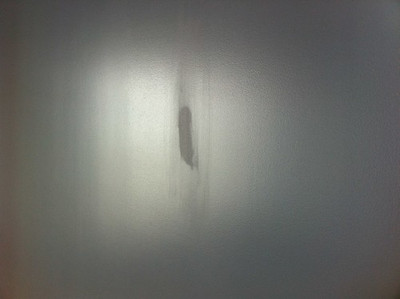Why Does Filler Flash (or Grin) Through Paint
Matthew Morgan on 17th Sep 2025
You’ve spent time repairing a wall, sanding it smooth, and painting over the patch – only to notice that the repaired area still shows through as a dull, lighter, or shinier patch. This frustrating issue is known as flashing, sometimes also called grinning through.
At BRWSH, we hear this question a lot: “Why does filler grin through my paint, and what can I do to stop it?” The good news is that it’s preventable, and fixable, once you understand what’s going on.
Why Does It Happen?
Flashing or grinning happens because the surface of filler behaves differently to the rest of the wall. One of the main reasons is porosity. Filler is often more absorbent than plaster or previously painted surfaces, which means it soaks up paint unevenly and leaves behind a patch that looks lighter or duller than the surrounding area.
Texture plays a big part too. Even if you’ve sanded the filler until it feels silky smooth, the surrounding wall may have been painted with a roller that left a subtle stippled finish. Against that texture, the smooth patch stands out and becomes noticeable once painted over.
Another common cause is incomplete drying. If the filler hasn’t been given enough time to cure fully, it will continue to draw moisture from the paint as it dries, leaving behind uneven colour or sheen. In some cases, especially with cement-based fillers, the problem is chemical: the natural alkalinity of the material can react with paint, effectively “burning through” and creating a visible mark. Finally, sometimes it’s simply down to blending. If the patch is ever so slightly raised or sunken, the way the light hits it will highlight the difference, making the repair obvious.
How Can You Prevent or Fix It?
The key to avoiding flashing is preparation. First and foremost, give filler the time it needs to dry. Rushing straight in with paint almost always leads to problems. Once it’s cured, sanding becomes essential – not just to smooth the surface, but to ensure that the patch sits perfectly level with the wall around it. Using a flat sanding block will help keep everything flush.
Next, it’s important to seal the filler before applying your topcoat. You can do this with a mist coat – a watered-down layer of emulsion – or by using a good quality primer. This step reduces the difference in porosity and gives you a consistent base to work on. When it comes to finishing, don’t stop at a single coat of paint. Applying two or more topcoats, with proper drying time in between, will build up a uniform sheen across the wall and disguise any repairs.
If you find the problem keeps coming back, it may be worth upgrading your filler. High-quality products are designed to resist shrinking and flashing, and in some cases you can even add a little of your chosen wall colour into the filler before applying it. This clever trick means that even before painting, the repair is already blending into its surroundings.
The BRWSH Recommendation
If you’re battling with patches that keep flashing or grinning through, don’t worry – it’s a problem every decorator faces at some point. The solution is usually a mix of patience, preparation, and the right products. At BRWSH we stock Toupret fillers, Johnstone’s primers, and Tikkurila paints, all trusted by professionals for giving a flawless finish.
Drop into BRWSH in Cardigan for advice tailored to your project – we’re always happy to help you get the best results and make those filler patches disappear for good.

